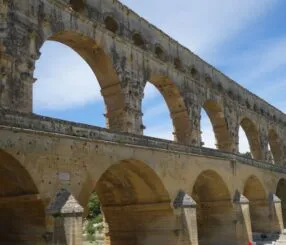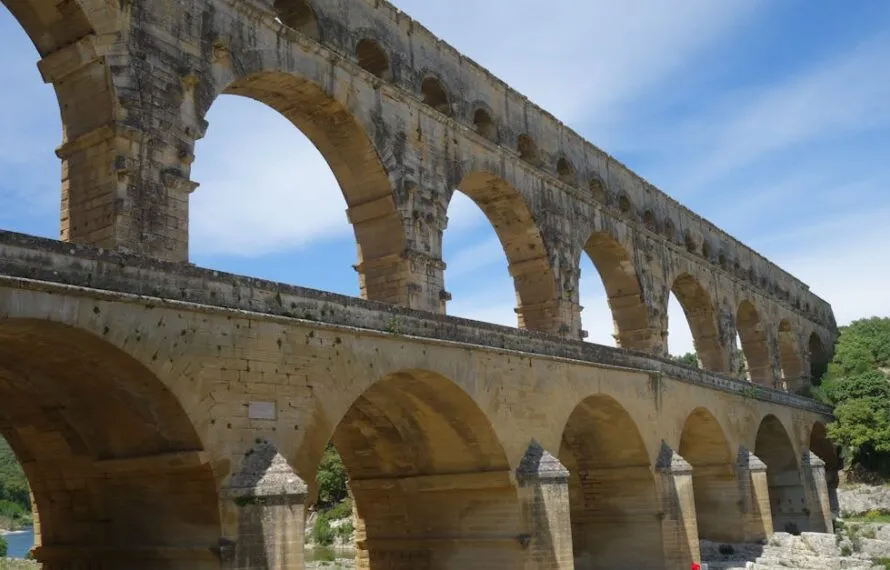Nestled in the heart of Southern France, the Pont du Gard stands as a testament to the ingenuity of Roman engineering.
This ancient aqueduct, with its towering arches and breathtaking views, draws visitors from around the world.
But for young EU residents, there’s a special allure: the possibility of free entry.
Let’s explore this fascinating site and uncover the benefits and details of visiting for those under 26.
O que este artigo aborda:
- Understanding the Pont du Gard
- Historical significance
- Architectural features
- Entry policies for EU residents under 26
- Current regulations
- Required documentation
- Benefits of free entry for young visitors
- Educational opportunities
- Cultural enrichment
- How to plan your visit
- Best times to visit
- Nearby attractions
- Frequently asked questions about Pont du Gard entry
- Common misconceptions
- Tips for a smooth visit
- Comparing entry policies with other historical sites
- Similar sites in France
- Differences in entry policies across Europe
- Impact of free entry on tourism
- Visitor statistics
- Economic implications
Understanding the Pont du Gard
Historical significance
The Pont du Gard isn’t just a marvel of architecture; it’s a bridge to the past.
Built in the 1st century AD, this aqueduct once carried water over 50 kilometers to the Roman colony of Nemausus, now known as Nîmes.
Its construction showcases the advanced engineering skills of the Romans and their ability to harmonize functionality with beauty.
The structure has withstood the test of time, surviving wars, weather, and the passage of centuries, making it a symbol of resilience and historical continuity.
Architectural features
Standing at nearly 50 meters tall, the Pont du Gard is a three-tiered aqueduct bridge made of precisely cut stones, some weighing up to six tons.
The arches, perfectly aligned, create a rhythmic pattern that is both functional and aesthetically pleasing.
The bridge’s design allowed it to efficiently transport water while blending seamlessly into the natural landscape.
Its construction without the use of mortar is a testament to the precision and skill of Roman builders.
Entry policies for EU residents under 26
Current regulations
For EU residents under the age of 26, the Pont du Gard offers free entry, a policy that aligns with France’s broader initiative to make cultural heritage accessible to younger generations.
This initiative aims to foster a deeper appreciation for history and culture among young people, encouraging them to explore and learn from the past.
Required documentation
To benefit from free entry, young visitors must present valid identification proving their age and EU residency.
This can include a passport, national ID card, or any official document that verifies both criteria.
It’s essential to have this documentation on hand to ensure a smooth entry process.
Benefits of free entry for young visitors
Educational opportunities
Free access to the Pont du Gard provides young visitors with a unique educational experience.
Walking through the arches and along the ancient stones offers a tangible connection to history, allowing them to learn about Roman engineering, architecture, and the historical context of the region.
This immersive experience can spark curiosity and inspire further exploration into history and archaeology.
Cultural enrichment
Beyond education, visiting the Pont du Gard enriches young visitors culturally.
It offers a chance to appreciate the artistry and craftsmanship of ancient civilizations, fostering a sense of pride and connection to European heritage.
This cultural enrichment extends beyond the site itself, as visitors can explore the surrounding region, known for its rich history and vibrant culture.
How to plan your visit
Best times to visit
The Pont du Gard is a popular destination, so timing your visit can enhance your experience.
Spring and early autumn offer pleasant weather and fewer crowds, making it ideal for exploring the site at a leisurely pace.
Early mornings or late afternoons provide the best lighting for photography and a more tranquil atmosphere.
Nearby attractions
While the Pont du Gard is a highlight, the surrounding area boasts numerous attractions worth exploring.
The nearby town of Uzès offers charming streets, a bustling market, and historical sites.
Nîmes, with its Roman amphitheater and temple, provides further insights into the region’s ancient past.
Additionally, the natural beauty of the Gardon River and surrounding countryside offers opportunities for hiking, picnicking, and enjoying the outdoors.
Frequently asked questions about Pont du Gard entry
Common misconceptions
Some visitors mistakenly believe that all entry to the Pont du Gard is free, regardless of age or residency.
However, the free entry policy specifically applies to EU residents under 26.
It’s important to verify eligibility and have the necessary documentation to avoid any confusion at the entrance.
Tips for a smooth visit
To ensure a smooth visit, plan ahead by checking the site’s opening hours and any special events or closures.
Arriving early can help you avoid crowds, and wearing comfortable shoes is advisable for exploring the site.
Don’t forget to bring a camera to capture the stunning views and architectural details.
Comparing entry policies with other historical sites
Similar sites in France
France is home to numerous historical sites with similar entry policies for young EU residents.
The Louvre Museum in Paris and the Palace of Versailles also offer free entry to this demographic, promoting cultural engagement and education.
Differences in entry policies across Europe
While many European countries have initiatives to make cultural sites accessible to young people, the specifics of these policies can vary.
Some countries may offer discounted rates rather than free entry, and eligibility criteria might differ.
It’s always wise to research the entry policies of specific sites when planning a visit.
Impact of free entry on tourism
Visitor statistics
The policy of free entry for young EU residents has contributed to an increase in visitors to the Pont du Gard.
This demographic is more likely to explore cultural sites when cost is not a barrier, leading to a more diverse and engaged audience.
Economic implications
While free entry might seem like a financial loss, it can have positive economic implications.
Increased foot traffic can boost local businesses, from restaurants to souvenir shops, and promote tourism in the broader region.
Additionally, fostering a love for cultural heritage among young people can lead to lifelong engagement and support for preservation efforts.
In conclusion, the Pont du Gard offers a unique opportunity for young EU residents to explore a piece of history without the barrier of entry fees.
This policy not only enriches their understanding of the past but also supports the local economy and promotes cultural appreciation.
Whether you’re drawn by the architectural marvel or the historical significance, a visit to the Pont du Gard promises an unforgettable experience.





Sem comentários